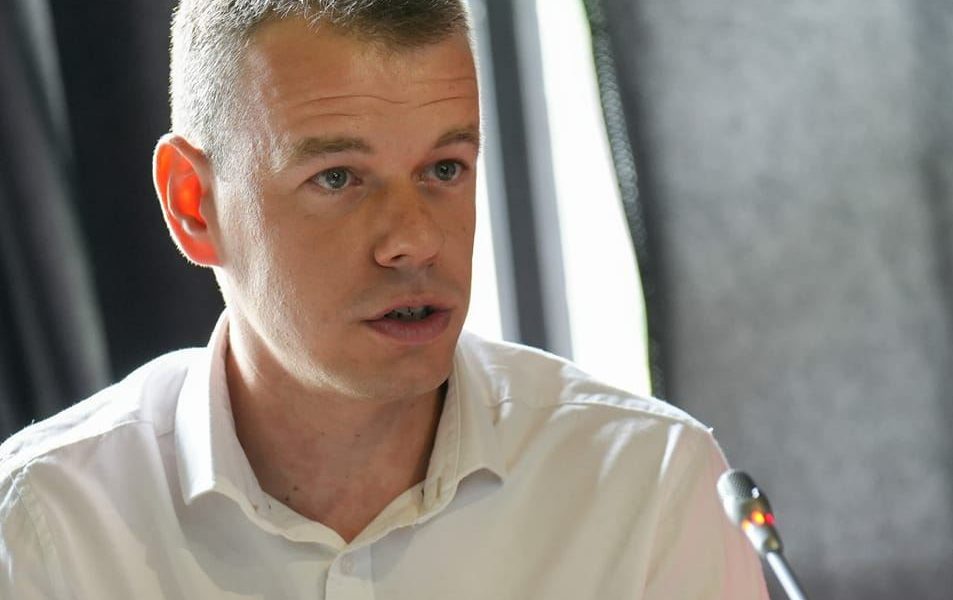At the end of May 2025, the Minister for Human and Minority Rights and Social Dialogue in the then newly formed Government of Serbia, Demo Beriša, opened the conference “The Suffering of Roma during the Conflict in Kosovo and Metohija” as the envoy of the Prime Minister of the Republic of Serbia.
The Minister stated that we must not forget the Roma living in the territory of “the southern Serbian province,” as they—alongside the Serbian people in that area, who are the most endangered—also find themselves in an extremely difficult situation and are in need of the assistance and support of the Government of Serbia, which has recognized the importance of this conference and backed its work. “Roma are our brothers, comrades, and neighbors. We must help them by creating employment opportunities, involving them in all spheres of society, and providing the necessary conditions for improving their status,” Minister Beriša concluded.[1]
At the beginning of the same month, one of the grave racist attacks on a Roma family occurred near Kraljevo. Information about the attack was published on the Instagram page “Roma Voice for Justice.” According to their post, the multi-member Gaši family was physically assaulted on the evening of May 3 by a group of around twenty people near their home. That group, as reported by members of the Gaši family and relayed on the “Roma Voice for Justice” Instagram page, also set fire to a pile of straw in front of their house while verbally abusing them on ethnic ground.[2]
According to the statements of Sermin Gaši, a group of men from the village came on Saturday evening in front of their yard, set fire to bales of hay next to the fence and inside the yard of the house where, as he says, 20 family members live.
“They cursed my Gypsy mother, they cursed my Albanian mother. He told me I was a Turk. I’m not a Turk, I’m not an Albanian. He told me—now I’ll set you on fire in your house. They hit me there and tried to throw me into the fire. Then my wife came with our 10-month-old baby and pulled me away. They slapped my 10-month-old child,” said Gaši from Tavnik near Kraljevo.[3]
According to Radio Free Europe (RFE), the Gaši family came to Tavnik in 2021, having moved from Obilić, Kosovo, to the Kraljevo area. As confirmed to RFE by the Commissariat for Refugees and Migration, the Gaši family purchased a rural household in the village of Tavnik in 2021 with funds provided by the Commissariat, “as part of a program aimed at improving the living conditions of internally displaced persons while in displacement.”
Although this attack was swiftly condemned by Minister Beriša, as well as by the Commissioner for the Protection of Equality and the National Council of the Roma National Minority, nearly five months later, none of the perpetrators who assaulted the Roma family—who, after the war and years of displacement, had finally settled near Kraljevo—have been arrested. The impunity for this attack can be understood in light of the marginalization of Roma suffering during the wars of the 1990s, particularly the war in Kosovo, and the resulting continuation of institutional discrimination.
That this practice is encouraged precisely by holders of the highest executive offices in Serbia—despite the message from May that “Roma are our brothers who need help”—is evidenced by the racist statement made by the Minister for Human Rights in July of this year. On July 22, Demo Beriša stated that “Roma must understand that the state and municipalities are not ATMs” and that “it is necessary for them to be gainfully employed.” This racist remark was condemned by the A11 Initiative, which announced it would file a complaint with the Commissioner for the Protection of Equality over Beriša’s discriminatory statement.[4]
Given that the minister often appears in the media alongside war criminals such as Vinko Pandurević, or attends gatherings of the Serbian Radical Party in the company of Vojislav Šešelj—held at the very site of the wartime crime of the expulsion of Croats in Hrtkovci,[5] Beriša’s racist attitude toward the Roma is rooted in his denial of their suffering during the wars of the 1990s. For that reason, he views the suffering of Roma during the Kosovo war selectively—seeing them only as victims of the Kosovo Liberation Army—and therefore, at events dedicated to the suffering of Roma during the Kosovo war, he avoids speaking about those who were victimized by the Yugoslav Army.
The impunity surrounding the current racist attacks against Roma stems from the erasure of memory of their wartime suffering. Just as one might clear a phone’s memory, various representatives or defenders of grand national projects erase the suffering of the Roma as easily as clearing cache memory, in order to make room for their own chauvinistic “memory apps” based on the denial or appropriation of others’ suffering.
A 2003 report by the Humanitarian Law Center revealed that during the war, Kosovo Roma were often forced by Serbian forces to assist in looting and destroying Albanian property and in burying Albanian civilians after crimes were committed. As a result, in numerous testimonies, Roma see themselves as the primary victims of the KLA after the war. Roma houses were targeted, their property was seized as allegedly stolen Albanian property, and they were subjected to physical abuse to extract confessions to crimes against Albanians.[6]
There are no comprehensive data on the number of Roma who were victims of war crimes, but in 2001 the international organization Human Rights Watch stated that it believed hundreds of members of the Roma minority had been victims of crimes such as physical abuse, torture, abduction, murder, and rape. Data from the Humanitarian Law Center from 2003 indicate that 543 Roma were killed and 593 went missing.[7]
Despite having made up a significant portion of Kosovo’s population before the conflict, the Roma found themselves trapped in a war that demanded loyalty and left no room for neutrality. Forced to choose sides in a conflict where neither side recognized them ethnically, Roma faced a profound dilemma. Some Roma leaders from Kosovo took part in the negotiations on Kosovo’s future held in Rambouillet, France, as part of the Serbian delegation in early 1999. However, the majority of Roma remained politically unengaged, seeking ways to protect themselves from the impending ethnic violence.
Caught in that trap between two nationalisms, the Roma community in Kosovo faced collective accusations of collaboration with Serbian armed forces during the war. Negative portrayals on social media and, to some extent, ongoing political discourse have intensified xenophobia toward Roma communities both in Kosovo and in Serbia, further deepening their marginalization.
Immediately after the NATO-led KFOR forces entered Kosovo and the units of the Yugoslav Army and Serbian police withdrew, Human Rights Watch published a comprehensive report revealing the grave situation faced by ethnic Serbs and Roma in Kosovo—one marked by an atmosphere of fear, uncertainty, and violence.[8] As reported at the time by the United Nations High Commissioner for Refugees (UNHCR), a wave of arson and looting followed, targeting Serbian and Roma homes across Kosovo. Those from these communities who remained in Kosovo endured constant harassment, intimidation, and brutal attacks.
Immediately after the war in 1999, the homes of Roma, Ashkali, and Egyptians were set on fire along with Serbian houses, and the Roma, Ashkali, and to some extent Egyptian communities also faced deadly attacks, abductions, and other forms of violence. Roma men were arbitrarily detained, interrogated, and subjected to severe beatings, and some individuals are still listed as missing.
In post-war Pristina, an ethnic cleansing of Roma, Ashkali, and Egyptian community members took place, with reports specifically noting the disappearance of five neighborhoods that had previously been home to Roma. “We saw this especially in 1999. Pristina had five Roma neighborhoods—today, not a single one exists. ‘Divanjole’ no longer exists, ‘Kolibarska’ no longer exists, ‘Varoš’ no longer exists, ‘Moravska’ no longer exists—none of them exist. That is ethnic cleansing; it means the destruction of those who were labeled ‘spies,’ the destruction of their property,” said historian and activist Shkëlzen Gashi in 2024. He described the eradication of these neighborhoods as a form of ethnic cleansing, pointing to it as the destruction of both the community and its property.[9]
The case of Skender Bislimi is illustrative when discussing the involvement of Roma in the Kosovo war. In 2018, the Pristina court sentenced this 58-year-old Roma member of a Serbian paramilitary group to ten years in prison for torturing more than 40 Albanian civilians in March 1999 during the war in Kosovo. Bislimi, along with at least ten others, terrorized civilians—forcing men to kneel, beating them, and making them sing Serbian nationalist songs. Arrested in Bosnia and extradited to Kosovo in 2016, Bislimi became the first Roma convicted of war crimes in this conflict.[10] His case highlights the scope of the abuses suffered by Kosovo Roma, who were often coerced by members of the Serbian armed forces and consequently faced retaliation after the war.
The minimum guarantee that contemporary, direct, and institutional violence against Roma will be punished is that their wartime suffering must not be swept under the rug or erased like cache memory. That is why, within the framework of the Berlin Process last year, the Youth Initiative for Human Rights recommended that the states of the former Yugoslavia create commemorative programs and monuments dedicated to the wartime suffering of the Roma.[11] Institutional remembrance, which includes a registry of war victims listing Roma as well as memorial sites, would then serve as a reminder that violence such as that committed against the Gaši family must never be repeated.
Marko Milosavljević is the Head of Research and Advocacy at the Youth Initiative for Human Rights in Serbia (YIHR). His primary area of work involves educating young people about dealing with the legacy of war, as well as conducting research on accountability for war crimes and activism against the glorification of war criminals. A particular focus of his work is monitoring the impunity for human rights violations against marginalized groups in Serbia. Marko was the editor of the publication “Kosovo Chronology (1974–2017)” and one of the authors and editors of the publication and website “The War in Serbia (1991–2001): It Did Happen”, published by YIHR.
[1] https://minljmpdd.gov.rs/ministar-berisa-otvorio-konferenciju-stradanje-roma-za-vreme-sukoba-na-kosovu-i-metohiji/
[2] https://www.slobodnaevropa.org/a/srbija-tavnik-kraljevo-napad-romska-zajednica/33409464.html
[3] https://www.rts.rs/lat/vesti/srbija-danas/5707326/osuda-napada-na-rome-u-tavniku-kod-kraljeva.html
[4] https://www.a11initiative.org/inicijativa-a-11-prituzba-poverenici-zbog-izjava-ministra-berise-neprihvatljiv-stav-da-romi-drzavnu-kasu-tretiraju-kao-bankomate/
[5] https://www.insajder.net/teme/berisa-o-odlasku-na-seseljevu-proslavu-u-hrtkovcima-nisam-bio-kao-ministar-vec-kao-privatno-lice-video
[6] Humanitarian Law Center, Report: Roma in Serbia, 2003: https://www.hlc-rdc.org/publikacije/romi-u-srbiji/
[7] Ljupka Mandić Kalijašević, Long-Neglected Stories of Roma about the Lasting Impact of the War in Kosovo, BIRN, 2023: https://balkaninsight.com/sr/2023/01/09/dugo-zanemarivane-price-roma-o-trajnom-uticaju-rata-na-kosovu/
[8] Human Rights Watch. “Abuses against Serbs and Roma in the New Kosovo.” August 1, 1999. Available at: https://www.hrw.org/report/1999/08/01/abuses-against-serbs-and-roma-new-kosovo.
[9] Statement by Shkëlzen Gashi available here: https://www.epokaere.com/shkelzen-gashi-thote%CC%88-se-shqiptare%CC%88t-pas-lufte%CC%88s-be%CC%88n-spastrim-etnik-ndaj-komunitetit-rae
[10] https://balkaninsight.com/sr/2021/11/12/osudenik-za-ratne-zlocine-na-kosovu-preminuo-u-bolnici/
[11] https://yihr.rs/bhs/preporuke-radne-grupe-za-suocavanje-prosloscu-pomirenje-predstavljene-u-okviru-berlinskog-procesa/




